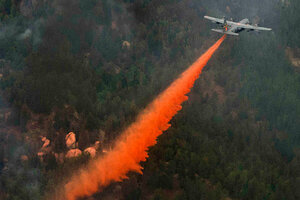Colorado wildfire: Have we learned any lessons?
Ten years after the devastating Hayman Fire caused policy changes and a new federal law, another massive Colorado wildfire is causing destruction. Experts have a good idea about what's wrong, but fixing it is another matter.

A US Air Force C-130 Hercules aircraft spreads fire retardant to fight the Waldo Canyon wildfire in Colorado Springs, Colo.
Staff Sgt. Stephany Richards/USAF/REUTERS
By all accounts, the fires were devastating. More than 130 homes torched, 38,000 people evacuated, 138,000 acres to the west of Denver and Colorado Springs incinerated, in some places fires burning so hot that nothing but topsoil remained.
This was 10 years ago, when the ravages of what came to be known as the Hayman Fire prompted numerous studies and led to federal law designed to reduce the chances of such apocalyptic fires recurring again.
“The Hayman Fire has taken on national significance by becoming an example of a consequence of what is wrong with current forest management policy in this country,” the US Forest Service concluded in a September 2003 report. “Consequently, the more we can learn from it, the more we can use the Hayman experience to inform future debates over both forest and wildfire management strategies.”
As of Friday, Colorado was reeling from what most officials were calling an even more destructive blaze: in Waldo Canyon, on Colorado Springs’s northwest fringes, flames have forced evacuations of 35,000 people, destroyed at least 346 homes and charred 19,000 acres. Coming just weeks after High Park blaze destroyed 257 homes in Fort Collins, north of Denver, 2012 has turned into the most destructive wildfire year in Colorado history.
“It’s a growing population, it’s the reduced amount of water, it’s a changing climate and it’s the bark beetle – it’s a perfect storm of factors I suppose,” says Brian Rutledge, regional vice president for the National Audubon Society. “Learning is one thing, being able to act is quite another.”
At the time, the destruction of the Hayman blaze stunned both Colorado and the country. Images of flames ripping through communities and reducing mountainsides to ashen moonscapes prompted many to criticize the US Forest Service, whose management policies had disrupted the pattern of cyclical fires that periodically swept through wilderness area cleaning out dead trees and debris but without the catastrophic consequences. By doing that and by encouraging clear-cutting rather than selective cutting, the Forest Service unintentionally made forests prone to bigger, more destructive fires.
“We understand 100 years later that fire is Mother Nature’s way of keeping nature clean, it’s housekeeping,” says Carol Ekarius, executive director of the Coalition for the Upper South Platte, an organization that helped restore charred forests in a watershed larger than Rhode Island. “What we have here is the law of unintended consequences that’s coming back to haunt in full blush.”
Forest ecologists say severe, recurring droughts since the mid-1990s have weakened trees throughout the Front Range of the Colorado Rockies, opening the door for infestations of bark beetles. Weakened and dead trees pile up on the forest floors, leaving carpets of flammable debris that, due to budget cuts and shifting policies, aren’t cleared out or burned in a controlled manner.
Add to that the fact that housing development has pushed into areas that were once considered too remote for building – what land specialists called the “wildland-urban interface” – and standards for building “defensible space” around houses vary widely. Many homeowners landscape with water-intensive lawns and many are averse to unsightly preventative burns or smaller scale timber harvesting – known as “fuel reduction” designed to prevent the buildup of flammable tinder.
“In the last 20 years, everyone wants to build a house in the forest, everyone wants a second home in the forest out west and people are failing to recognize they’re building a house in a very fire-prone habitat,” says Mark Ashton, a professor of forest ecology at the Yale School of Forestry and Environmental Studies in New Haven, Conn. “People are building houses out in the wilderness because it’s beautiful, and it is, but Mother Nature doesn’t recognize that. Urban dwellers have divorced themselves from the realities of nature.”
“There’s a public that thinks that anything to do with cutting is bad,” Dr. Ashton says.
“Lawns, in my opinion, should be illegal in this area,” Mr. Rutledge says. “We can’t afford the water.”
The economic downturn has also crimped budgets on local, state and federal levels, and as fires becomes more destructive, people demand more money for fighting fires instead of preventing fires. Joe Duda, deputy state forester at the Colorado State Forest Service, says some federal agencies are spending up to 40 percent of their budgets on reacting to wildfires, crowding out other programs. Headwater Economics, a Montana-based research organization, estimates total costs of fighting fires now exceed $3 billion annually and will continue to grow as more people build homes in wildland areas.
“It’s a Catch-22, more of your budget has to go to fire, less of your budget goes to timber management, fuel reduction and the less fuel reduction you have, the greater the fire risk,” Mr. Duda says.
The hundreds of millions of dollars caused in the Hayman fire destruction eventually led to the Healthy Forest Restoration Act, a law signed by President George W. Bush in 2003 that sought to make major changes in fire fighting policies. Many predict that the images of Waldo Canyon homes being reduced to ashes and thousands forced into emergency shelter – not to mention fires burning in at least four other Western states – will have a similar emotional impact. But whether that results in a once again in large-scale policy changes, and whether it will make any difference, is an open question.
“We humans have a tendency to deny the impact of nature,” Rutledge says. “To pretend we have the control over nature is the greatest egotism.”

